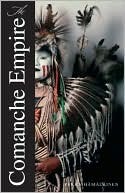More on this book
Community
Kindle Notes & Highlights
Comanche violence was fueled by the gifts, goods, and guns that flowed into Comanchería from the United States.
1808, a year after the U.S. agent John Sibley had courted Comanches in Natchitoches and Comanches had replaced their Spanish flag with an American one, Spanish officials in San Antonio sensed that their ties to the Comanche nation were
in jeopardy.
In 1806, for example, the rifles intended for Indian allies were of larger caliber than usual and Comanches refused to accept them because they were difficult to handle on horseback.
Americans did not necessarily read Comanche culture any better than Spaniards did. Instead, their fuller adherence to Comanche conventions may have been—at least in part—a fortuitous accident made possible by the ways in which their commerce with the Comanches was structured.
Comanches did take advantage of this ecological potential and built massive domestic horse herds, but they still preferred to fuel much of their trade with plundered animals.
So close, in fact, was the association between livestock raiding and trading that Comanches kept two separate sets of animals that served different economic and cultural needs.
sell his favorite horse to the American, explaining that trading the animal “would prove a calamity to his whole band, as it often required the speed of this animal to insure success in the buffalo chase…. Moreover, he said (patting his favorite on the neck), ‘I love him very much.’”17
The grandiose title notwithstanding, the treaty bespoke Mexico City’s desperate need to reach a settlement with the Comanches, who controlled the balance of power in Mexico’s far northern borderlands.
Finally, the Comanche nation was assigned an emissary-interpreter who would be in permanent residence in San Antonio and have direct access to the Mexican secretary of state.
Replicating their policies toward Spanish New Mexico in the 1760s and 1770s and Spanish Texas in the 1800s and 1810s, Comanches alternated raiding and trading with Mexican Texas. They plundered farms and ranches for livestock and captives, but traded peacefully in San Antonio and Nacogdoches.
Gift payments, in short, had become the condition for peace, turning Texans into tributaries of the imperial Comanches.
Although it yielded only imperfect protection, the policy of paying for peace gave the vital Tejano regions of Texas much-needed if tenuous respites from violence.
But the policy also had the unintended effect of redirecting Comanche raids into other northern Mexican departments.
Rather than moving to the interior to shield the province’s core areas around San Antonio from Comanche attacks, most Americans stayed east of the Colorado River, beyond the Comanche range and within an easy reach of Louisiana, their main commercial outlet.
was this divided Texas that in 1835 rebelled against the central government and in 1836 became an independent republic with close ties to the United States. The Texas Revolution was the product of several long-simmering problems, which came to a head in 1834 and 1835 when the military strongman Antonio López de Santa Anna assumed dictatorial powers in Mexico City and imposed a conservative national charter known as Las Siete Leyes.
Comanches kept an unbroken peace with New Mexico from 1786 until the end of the Spanish colonial era. But this does not mean that the relations between Spanish New Mexico and western Comanches had become cleansed of contention, for beneath a thin veneer of tranquility the Comanches and colonists were engaged in an intense rivalry.
After the landmark treaty of 1786 between Chief Ecueracapa and Governor Juan Bautista de Anza, Spanish officials believed that the complete subjugation of the western Comanches was but a matter time. The architects of New Mexico’s Indian policy had a specific plan for the western Comanches who were to be made dependent on Spanish gifts and goods, isolated from the United States, and, eventually, Hispanized.


